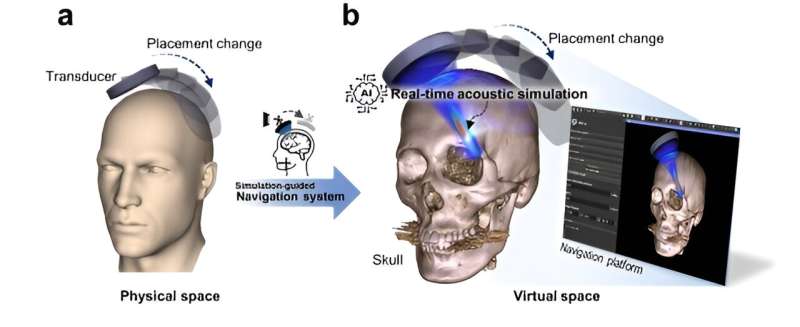This article has been reviewed according to Science X's editorial process and policies. Editors have highlighted the following attributes while ensuring the content's credibility:
fact-checked
peer-reviewed publication
trusted source
proofread
Artificial intelligence lowers the barrier to ultrasound brain disease treatment

Focused ultrasound technology is a non-invasive treatment method that focuses ultrasound energy on a few millimeters of the brain, including deep regions, to treat neurological disorders without opening the skull. It has been applied to the treatment of various intractable brain diseases such as depression and Alzheimer's disease because it minimizes the impact on the surrounding healthy tissue and reduces side effects such as complications and infections.
However, its use has been limited so far because it is difficult to reflect the distortion of ultrasound waves caused by the different shapes of the skulls of different patients in real time. Until now, the clinical applicability of AI simulation models in the field of non-invasive focused ultrasound therapy technology has not been validated.
A research team led by Dr. Kim, Hyungmin of the Bionics Research Center at the Korea Institute of Science and Technology (KIST) has now developed a real-time acoustic simulation technology based on generative AI to predict and correct the distortion of the ultrasound focus position caused by the skull in real-time during focused ultrasound therapy. The study is published in the journal NeuroImage.
To predict the location of the invisible acoustic focus, navigation systems based on medical images taken before treatment are currently utilized, which provide information about the relative position of the patient and the ultrasound transducer. However, they are limited by their inability to account for the distortion of ultrasound waves caused by the skull, and while various simulation techniques have been used to compensate for this, they still require significant computational time, making them difficult to apply in actual clinical practice.
The research team developed a real-time focused ultrasound simulation technology through an artificial intelligence model based on a generative adversarial neural network (GAN), a deep learning model widely used for image generation in the medical field.
The technology reduces the update time of three-dimensional simulation information reflecting changes in ultrasound acoustic waves from 14 s to 0.1 s, while showing an average maximum acoustic pressure error of less than 7% and a focal position error of less than 6mm, both of which are within the error range of existing simulation technologies, increasing the possibility of clinical application.
The research team also developed a medical image-based navigation system to verify the performance of the developed technology in order to rapidly deploy it to real-world clinical practice. The system can provide real-time acoustic simulations at the rate of 5 Hz depending on the position of the ultrasound transducer, and succeeded in predicting the position of the ultrasound energy and focus within the skull in real-time during focused ultrasound therapy.
Previously, due to the long calculation time, the ultrasound transducer had to be precisely positioned in a pre-planned location to utilize the simulation results. However, with the newly developed simulation-guided navigation system, it is now possible to adjust the ultrasound focus based on the acoustic simulation results obtained in real time. In the future, it is expected to improve the accuracy of focused ultrasound and provide safe treatment for patients by being able to quickly respond to unexpected situations that may occur during the treatment process.
"As the accuracy and safety of focused ultrasound brain disease treatment has been improved through this research, more clinical applications will emerge," said Dr. Kim, Hyungmin of KIST. "For practical use, we plan to verify the system by diversifying the ultrasound sonication environment, such as multi-array ultrasound transducers."
More information: Tae Young Park et al, Real-Time Acoustic Simulation Framework for tFUS: A Feasibility Study Using Navigation System, NeuroImage (2023). DOI: 10.1016/j.neuroimage.2023.120411




















